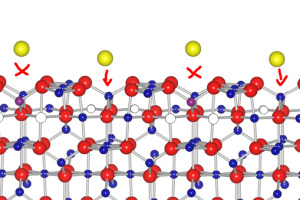The modern mystery of a well-known material is solved

FAU researchers discover the key to iron oxide’s unique structure
Magnetite is often used as a catalyst in chemical reactions. Other metal atoms can be bonded on its surface in such a way that they remain separated from one another and do not form larger metal particles. Researchers suspect that this speeds up chemical reactions particularly well. However, how this property comes about was previously unknown. Researchers from the Vienna University of Technology and FAU have recently shown that the secret lies in the unique structure of iron oxide’s surface. Their findings have recently been published in the renowned journal Science.*
Iron(II,III) oxide – better known as magnetite – has interested humans for thousands of years due to its magnetic properties and was used in compasses for navigation in antiquity. Today, it is no longer the material’s magnetic properties that researchers find especially interesting but what happens on the surface of an iron oxide crystal, as these processes are responsible for iron oxide’s excellent catalytic properties.
Left: Electrons are diffracted in particular directions due to the crystal lattice. The variations in the intensity of the individual reflexes form a kind of finger print of the surface’s structure. Right: The almost perfect correspondence between the experiment and theory demonstrate how well this method of diffraction can be used for this system. (Image: FAU/Chair of Solid-State Physics)
For this reason, researchers from FAU’s Chair of Solid-State Physics, together with researchers from the Vienna University of Technology, have investigated the structure of the surface. It is comparatively easy to describe the structure on the inside of the crystal – each iron and oxygen atom has its specific place in a repeating pattern. ‘In contrast, we were interested in how the atoms are arranged in the outer-most layers of the crystal where this symmetry is broken,’ explains Prof. Alexander Schneider.
The researchers observed that there are fewer iron atoms on the surface and that they are also arranged differently than on the inside of the crystal in the practically unchanged oxygen lattice. This creates vacancies for atoms and molecules which attach to the surface from the outside. That disproves the previous assumption that the chemistry of metal oxide surfaces is determined by missing oxygen atoms. The findings suggest that the mechanism of vacancies formation and reordering of metal atoms in the intact oxygen lattice may also be effective on the surfaces of many other metal oxides.
A specialism in Erlangen
Despite the availability of modern experimental and theoretical methods, uncovering the structure of such a complex material is a difficult task. The Erlangen-based research group were able to do this using low-energy electron diffraction (LEED). In this method, electrons are fired at the crystal which are then diffracted at its surface in specific directions. Based on the intensity of the diffracted electron beams, researchers can use complex model calculations to determine the structure of the surface. By using this method the working group at FAU’s Chair of Solid-Stated Physics, led by Prof. Klaus Heinz, who has since entered retirement, earned themselves a reputation as some of the leading researchers working on determining the atomic structure of crystal surfaces. ‘The correspondence between experimental findings and comparative calculations achieved in this study is so good that not only do we know exactly what the surface of iron oxide is like, we are also able to demonstrate that – contrary to popular opinion in the field – this method of electron diffraction is very good at describing this class of material,’ explains Dr. Lutz Hammer.
*R. Bliem, et al. , Science, 5 December 2014, Vol. 346, #621 4; doi: 10.1126/science.1260556
Further information:
Dr. Lutz Hammer
Phone: +49 9131 8528404
lutz.hammer@physik.uni-erlangen.de
Prof. Dr. Alexander Schneider
Phone: +49 9131 8528405
alexander.schneider@physik.uni-erlangen.de